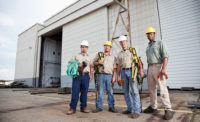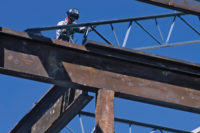2019 top standards- OSHA Most Frequently Violated Standards
OSHA fall protection standard
Fall protection — General Requirements (1926.501)

OSHA’s fall protection standard was the number one most-frequently cited agency standard in fiscal year 2018.
Enforcement citations FY 2018: 6,479
Number of inspections: 6,298
Proposed penalties: $31,266, 844
Most frequently cited industries
- Construction
- Wholesale trade
- Manufacturing
- Administrative and support and waste management and remediation services
- Utilities
Enforcement case study:
OSHA cited Midway Tower Service Inc. and Bracken Equipment Holdings LLC on September 17, 2018 for exposing employees to fall and struck-by hazards after an employee suffered fatal injuries at a Utica, Mississippi, worksite.
Midway Tower Service Inc. was cited for exposing employees to fall and struck-by hazards, failing to remove or replace damaged attachments between the hook of a crane and the load, and for not capping the ends of rebar. OSHA also cited Bracken Equipment Holdings LLC, a crane rental company, for not removing damaged equipment from service. The companies face $20,990 in proposed penalties.
“It is vital to establish and implement a comprehensive safety and health program that effectively addresses the hazards associated with communication tower work,” said OSHA Jackson Area Office Director Courtney Bohannon.
The companies have 15 business days from receipt of the citations and proposed penalties to comply, request an informal conference with OSHA’s area director, or contest the findings before the independent Occupational Safety and Health Review Commission.
Background:
Falls are among the most common causes of serious work related injuries and deaths. Employers must set up the work place to prevent employees from falling off of overhead platforms, elevated workstations or into holes in the floor and walls. OSHA requires that fall protection be provided at elevations of four feet in general industry workplaces, five feet in shipyards, six feet in the construction industry and eight feet in long shoring operations. In addition, OSHA requires that fall protection be provided when working over dangerous equipment and machinery, regardless of the fall distance.
To prevent employees from being injured from falls, employers must:
- Guard every floor hole into which a worker can accidentally walk (using a railing and toe-board or a floor hole cover).
- Provide a guard rail and toe-board around every elevated open sided platform, floor or runway.
- Regardless of height, if a worker can fall into or onto dangerous machines or equipment (such as a vat of acid or a conveyor belt) employers must provide guardrails and toe-boards to prevent workers from falling and getting injured.
- Other means of fall protection that may be required on certain jobs include safety harness and line, safety nets, stair railings and hand rails.
OSHA requires employers to:
- Provide working conditions free of known dangers.
- Keep floors in work areas in a clean and, so far as possible, a dry condition.
- Select and provide required personal protective equipment at no cost to workers.
- Train workers about job hazards in a language that they can understand.
Hazard protection
There are a number of ways employers can protect workers from falls, including through the use of conventional means such as guardrail systems, safety net systems and personal fall protection systems, the adoption of safe work practices, and the provision of appropriate training. The use of warning lines, designated areas, control zones and similar systems are permitted by OSHA in some situations and can provide protection by limiting the number of workers exposed. Whether conducting a hazard assessment or developing a comprehensive fall protection plan, thinking about fall hazards before the work begins will help the employer to manage fall hazards and focus attention on prevention efforts. If personal fall protection systems are used, particular attention should be given to identifying attachment points and to ensuring that employees know how to properly use and inspect the equipment.
Key Fall Protection standard takeaways
1926.501(a)(2)
The employer shall determine if the walking/working surfaces on which its employees are to work have the strength and structural integrity to support employees safely. Employees shall be allowed to work on those surfaces only when the surfaces have the requisite strength and structural integrity.
1926.501(b)(1)
“Unprotected sides and edges.” Each employee on a walking/working surface (horizontal and vertical surface) with an unprotected side or edge which is 6 feet (1.8 m) or more above a lower level shall be protected from falling by the use of guardrail systems, safety net systems, or personal fall arrest systems.
1926.501(b)(2)(ii)
Each employee on a walking/working surface 6 feet (1.8 m) or more above a lower level where leading edges are under construction, but who is not engaged in the leading edge work, shall be protected from falling by a guardrail system, safety net system, or personal fall arrest system. If a guardrail system is chosen to provide the fall protection, and a controlled access zone has already been established for leading edge work, the control line may be used in lieu of a guardrail along the edge that parallels the leading edge.
1926.501(b)(3)
“Hoist areas.” Each employee in a hoist area shall be protected from falling 6 feet (1.8 m) or more to lower levels by guardrail systems or personal fall arrest systems. If guardrail systems, [or chain, gate, or guardrail] or portions thereof, are removed to facilitate the hoisting operation (e.g., during landing of materials), and an employee must lean through the access opening or out over the edge of the access opening (to receive or guide equipment and materials, for example), that employee shall be protected from fall hazards by a personal fall arrest system.
Compliance resources:
The following references aid in recognizing fall protection hazards.
- OSHA Training. Provides links to training and education resources as well as courses provided by the OSHA Training Institute in occupational safety and health for federal and state compliance officers, state consultants, other federal agency personnel, and the private sector.
- Small Business Handbook. OSHA Publication 2209, (2005). Helps small business employers meet the legal requirements imposed by the Occupational Safety and Health Act of 1970 (the Act), and achieve an in-compliance status before an OSHA inspection.
- Fall Protection Training Guide. The Labor Occupational Health Program (LOHP) at UC Berkeley via Electronic Library of Construction and Occupational Safety and Health (ELCOSH): The Center for Construction Research and Training (CPWR). A guide on fall protection training including questions to ask, subjects to cover and a sign-off form.
- Fall Protection - Safety Walkaround Checklist. The Labor Occupational Health Program (LOHP) at UC Berkeley via Electronic Library of Construction and Occupational Safety and Health (ELCOSH): The Center for Construction Research and Training (CPWR). A checklist to be used when looking for fall hazards and making sure that proper preventative measures, such as fall protection, are in place. Part of a collection. Click on the 'collection' button to access the other items.
- Fall-Protection Harnesses: Hazard Alert. The Center for Construction Research and Training (CPWR), (2012). Covers harnesses used for fall protection, including how to choose the correct one, training, using, and inspections.
Looking for a reprint of this article?
From high-res PDFs to custom plaques, order your copy today!







